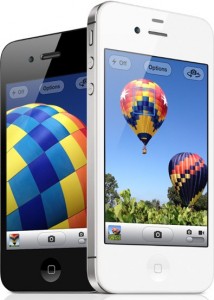iPhone 4S is a worldphone that's not, but sales will still rocket
 Apple’s product announcements are a tale of two iPhones: the iPhone 4States and the Immortal 3GS.
Apple’s product announcements are a tale of two iPhones: the iPhone 4States and the Immortal 3GS.
Today at Apple’s annual event, new CEO Tim Cook unveiled evolved iPods, a new dual-core iPhone 4S, and the voice-controlled virtual assistant based on Apple’s acquisition of Siri. He also recapped on iOS 5 and iCloud which were announced back in June. Although Apple sells two-thirds of their iPhones outside the US, I fear that the most innovative new parts of the iPhone 4S product design will appeal most to a US audience. Apple will still do well globally, but it could do even better with some tweaked product thinking.
Much more significantly, Apple now is moving to a three iPhone model portfolio: Apple will continue to sell both last years’ iPhone 4 and the previous years’ iPhone 3GS at cheaper price points. This will dramatically boost Apple’s phone sales volumes and enable Apple to compete head on with more Android smartphones.
The Immortal iPhone 3GS
The decision to keep on the 3GS as well as the old iPhone 4 is a massive move for Apple. It will extend the iPhone competitive threat to rivals into the mid tier of the mobile market. Apple’s competitors have often sidestepped the full force of the iPhone threat by positioning their models as cheaper phones. That strategy is now being squeezed and may become untenable in the US market.
Apple is positioning to counter Android with the new pricing and continued use of the iPhone 3GS.
Apple is motivated by great margins and not premium end user prices. If Apple can deliver keen prices to grab a market without sacrificing margins they will. The growth of the iPod product portfolio over the years as Apple’s economies of scales have enabled them to maintain margins yet lower prices demonstrates Apple’s aspirations: the new 2011 iPod Nano is the cheapest Nano Apple has ever launched. As the iPhone 3GS is so old, component prices will have fallen and Apple will have steadily improved manufacturing to minimize defects.
Those that are disappointed by the iPhone 4S’s identical appearance to its predecessor forget the success that its forerunner model enjoyed and in fact still enjoys. Back in 2009 there were similar comments to those being made today: Then, the new iPhone 3GS looked just the same as the older iPhone 3G. Those people were wrong then and so are they now:
- The iPhone 3GS sold over 30 percent more than its predecessor in its first year.
- The 3GS is still on sale today as Apple uses it to spearhead a move into the mid-tier and target more of the 95 percent of the handset market that doesn’t yet belong to Apple.
- iOS 5 runs on the iPhone 3GS. In other words it’s still being supported and will run the very latest Apple software.
In a market where product life cycles are often weeks, not months, and certainly not years, it is astonishingly impressive that a phone that’s over two years old is still a part of Apple’s phone portfolio.
The iPhone 4States
The iPhone 4S update copies the iPhone 3GS precedent. It has a completely different design under the bonnet despite having the same screen and exterior industrial design. It’s actually a greater change as the 4S boasts a vastly improved camera with full 1080p image stabilized video recording, as well as better low-light performance with 8 megapixel stills, and delivers such a jump in processing power that makes possible the radically differentiated voice virtual assistant.
Make no mistake, the iPhone 4S will sell amazingly well. Its predecessor’s sales have been increasing quarter-on-quarter the longer it has been on sale, although the competition has been launching new smartphones continuously. In Q2 2011, Apple sold 20.3m iPhones compared with just 14.1m a year earlier when the iPhone 4 went on sale. The 4S is a better phone. It will sell in vast numbers.
But the iPhone 4S has two key innovative features that set it apart from the transition from the iPhone 3G to the 3GS. Both of these will help Apple most in the US, and not globally:
- The voice-powered intelligent assistant the users speak to. Based on technology acquired with Siri, the assistant allows users to talk and set up calendar appointments, search for restaurants, or check the weather, among many other tasks. While this is a feature that demos amazingly well and is strongly differentiated from rival smartphones, it will only be available in three languages initially: English, French and German. But by December, the iPhone 4S will be on sale in 70 countries. Most won’t benefit from the stand out iPhone 4S feature that Apple dwelled on in their presentation.
A key benefit from Siri technology will be in-car usage. The assistant will, I understand, work with Bluetooth headsets and in-car speakerphones. If so, this hands-free mode will have tremendous appeal in the US. It’s much more important than in Europe. US citizens drive twice as much as Europeans. In the most recent years for which data is available US inhabitants drove over 3,000 billion miles compared with 308 billion in the UK. That’s ten times as many miles in the US, although the US has only five times the UK’s population. (1) - Worldphone radios, ie a dual-mode CDMA and GSM design. This means the iPhone 4S will work on almost any mobile network globally. In Europe this has no impact as all mobile operators use GSM style networks. In the US, this will help the CDMA carriers -- Verizon and Sprint -- and their subscribers. Now, a Verizon iPhone 4S customer will be able to use their phone in Europe, Africa, Asia -- virtually anywhere. But, of the iPhones currently being sold in Q2, only 11 percent were activated on Verizon. Apple is in danger of designing for the minority.
Both iPhones Will Be Massive Successes
Despite all the caveats, this will be a huge year for Apple. The iPhone 3GS sets out Apple’s intent to grow strongly from its 5 percent mobile phone market share now. As Tim Cook explained, he could have used a more impressive sounding figure to present Apple’s market share. Rather than show iPhone volumes as a proportion of total phones, he could have compared iPhone sales with the much smaller smartphone market. He didn’t. Apple’s opportunity is much greater than the current smartphone market as all phones are becoming smart.
The iPhone 4S will sell well, too. Despite appearances, it’s a totally different phone from last years’ iPhone 4. Only the screen and the case are the same. And, remember, the 15-month year old iPhone 4 has still proved to be the one to beat in the market.
But even I have doubts this time. Apple is in danger of reversing the 80:20 rule and designing for a US minority rather than the global market. It won’t prevent another successful year ahead for Apple in mobile, but Apple could be doing even better, if that’s possible.
(1)
Sources:
UK, 2010 data: http://www2.dft.gov.uk/pgr/statistics/datatablespublications/roads/traffic/index.html
US, 2007 data: http://www.bts.gov/publications/national_transportation_statistics/
 Ian Fogg is a mobile industry analyst, consultant and product manager. He is a former principal at Forrester; research director at Jupiter Research; and marketing and/or product management at Psion, 3/Hutchison and Cable & Wireless Communications.
Ian Fogg is a mobile industry analyst, consultant and product manager. He is a former principal at Forrester; research director at Jupiter Research; and marketing and/or product management at Psion, 3/Hutchison and Cable & Wireless Communications.
